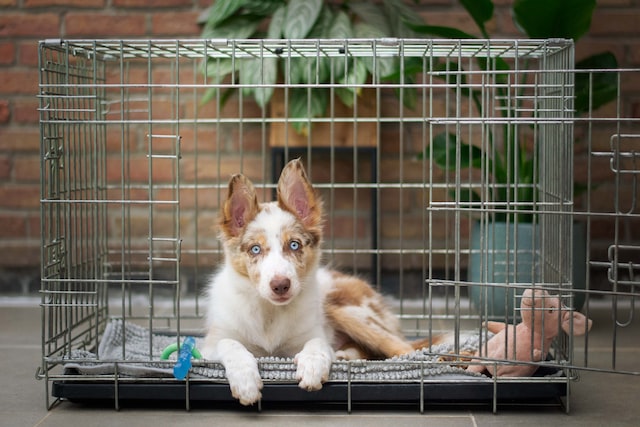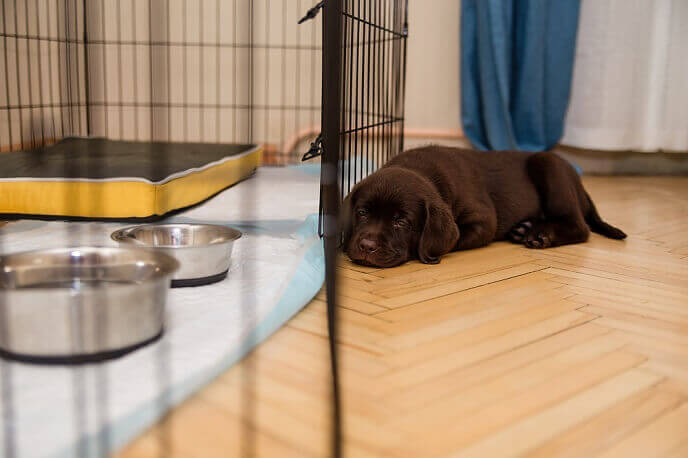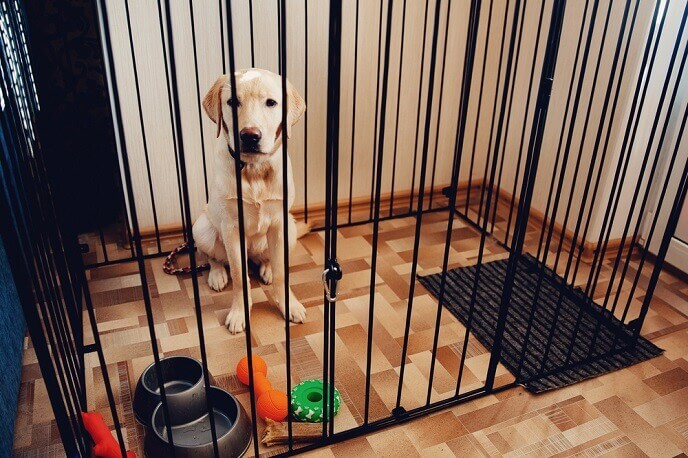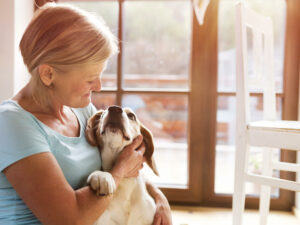Crate training has quickly become one of the first things that I teach my dogs. In fact, I tend to acclimate my furry best friends to a crate almost as soon as I bring them home.
There are several different reasons behind my doing this, all of which will be explained in this article.
Crate training your dog will be helpful for a couple of different reasons. For one thing, crate training your rescue dog will ensure that they are safe when you’re not at home. Secondly, crate training has been shown to help with housetraining for both puppies and adult rescue dogs alike.
Here we will be explaining everything that you need to know about crate training your rescue dog. This will also include answering some commonly asked questions about the process.
Let’s get into it!
Also Read: How to Help a Dog Adjust to a New Home
Choosing A Crate for a Rescue Dog
Before you even get to the process of crate training your new rescue dog, you will need to choose a crate for them.
There are many different models of crates out there from soft travel kennels to hard standing crates that are designed to blend in with the furniture in your living room.
All types of crates out there can be great for the right dog, but not every dog will be a good fit for every crate. The best crates will be of the right size, fits your needs, and fits your dog’s needs. Here we will be explaining how you can choose the right crate for your dog.
What Size Crate to Get?
Every crate should be large enough for your dog to stand up and turn around in comfortably. This is for both travel crates and standing crates.
While having some extra wiggle room in your dog’s crate is a good thing, you will also want to make sure that their crate isn’t too large either. This is because dogs will sometimes get into the bad habit of soiling their crate if there is too much room, especially if you are also housetraining your new dog at the same time.
Luckily, most crates will have size recommendations based on a dog’s height and weight. Following these guidelines will definitely steer you in the right direction.
Travel Crate vs. Standing Crate
If you do a lot of traveling, then getting your dog used to a travel crate alongside a standing crate is a good idea. This will make your dog feel much more comfortable when traveling. There are also some soft crates that can be great for those looking for a crate that can serve as both a travel crate and a crate for at home.
Which Type Crate To Pick? And Which To Avoid?
Once you have figured out what size and type of crate you need, you will then need to choose which type of crate will fit your dog best. Unfortunately, some dogs are more of an escape artist than others, so some dogs will also require a sturdier crate.
Purchasing a very sturdy crate is important if you have a strong dog that can escape a weaker made crate. This is especially true for travel crates, as you definitely do not want your dog escaping their crate when they’re being transported.
It is also important that you find a crate with metal bars that are not easy for your dog to chew, as this can be hazardous.
Unfortunately, this means that soft crates and aesthetic wooden crates may not be a good idea for strong dogs that are known to escape. This is because these types of crates tend to be weaker than metal ones.
However, these technically weaker types of crates are typically fine for dogs that do not chew their kennels or try to escape.
Crate Training a Rescue Dog in Six Steps

Photo by Ayla Verschueren on Unsplash
Your rescue dog is not likely going to be happy with their crate right away. After all, it is a confining space, which can be confusing and even stressful to dogs when they are not introduced to it properly. Luckily, crate training dogs is pretty easy to do!
Here we will be explaining how you can crate train your new rescue dog, whether he be old or young, scared or showing signs of separation anxiety.
Step 1: Get the Crate Set up in a Calm and Comfortable Location
The first thing that you will need to do is set up your dog’s crate in a calm part of the house. This could be in your living room, a spare bedroom, or another area where your dog feels comfortable.
It is also a good idea to set up your dog’s crate so that it is comfortable for them as well. You could put in a cushion, a soft crate liner, and even a blanket.
The best things to put into your dog’s crate are things that will make them feel at home and are safe to leave them alone with for extended amounts of time.
Many people will also get attachable food and water bowls for their dog’s crate. Having at least some water available to your dog when they are in their crate is a great idea, especially if they are going to be in there for an extended amount of time.
Step 2: Introduce Your Dog to the Crate
Once you have your dog’s crate all set up, you can then introduce your furry friend to it. You can do this by putting some small bits of treats in and around the crate. You could even make a fun game of it with toys as well.
It is important to remember that not every dog is going to be as enthusiastic about their crate as others. As a result, it could take your dog some time to go all the way into their crate.
Slowly introducing this new space to your dog and going at their pace is definitely worth it, and it will ensure that they have a good experience with their crate and not a negative one.
Step 3: Slowly Acclimate Your Dog to Being in the Crate With the Door Closed
Once your dog is comfortable with going inside the crate and laying down for a little while, you can then start getting them used to the idea of having their crate door closed.
You can start doing this by closing the door and immediately opening it again.
Giving your dog a yummy chew or a food stuffed toy can help with this process.
Once closing the door and opening it again is not a big deal, you can then leave it closed for around 30 seconds. If your dog doesn’t seem to mind, then you can then slowly increase this amount of time until you reach a few minutes. You should continue sitting in the same room as your dog at this stage.
If at any point your dog is showing signs of stress when having the door of their crate closed, then this is a sign that you are moving too quickly.
Simply decreasing the amount of time that the door is closed and increasing this amount of time more slowly will help better acclimate dogs that need some more time getting used to their crate.
Step 4: Put Your Dog in the Crate and Leave the Room for a Few Seconds
After your dog seems to be comfortable with having their crate door closed, you can then start leaving the room. It is a good idea to start by just leaving for around 30 seconds or so and slowly increasing this amount of time.
Giving your dog a lick mat, kong, or another type of toy will help provide your dog with a distraction when you are doing this.
Just like in step three, it is a good idea to go back to smaller time increments if your dog seems stressed out at any point in the process.
For example, if your dog was fine up until the three minute mark, then it is a good idea to practice leaving your dog alone for two and a half minutes several times in a row.
Then go to two minutes and forty seconds, two minutes and fifty seconds, then eventually three minutes again.
In this part of the process, a good goal to have is being able to leave your dog for ten minutes without any fuss. This is an especially good goal to meet for dogs that suffer from separation anxiety, as it will take them more time to get through this process.
Step 5: Continue to Slowly Increase the Amount of Time That Your Dog Spends in the Crate
Once your dog can be left in the crate for ten minutes at a time, then you can make the time jumps longer.
At this point, you should be able to realistically leave your dog in their crate for fifteen minutes without any trouble, and from there you can slowly increase this amount of time by five or ten minutes depending on your dog’s comfort level.
In some cases, you will still need to be very careful about increasing the amount of time that a dog is left alone, especially if they have severe separation anxiety. In these cases, it is best to continue increasing the amount of time that they are left alone slowly.
Once your dog can be left in the crate for about an hour with you being home, you can then move on to step six!
Step 6: Put Using the Crate to the Test
Now you will be able to start using the crate as you plan to use it in everyday life.
At this point, you should be able to leave your dog in the crate while you run to the grocery store or have them sleep in it throughout the night.
It is important to mention that adult dogs should never be left in a crate for more than five or six hours at a time during the day, and even this is lengthy and should only be done on occasion.
Puppies will need to be taken out of their crate more often than adult dogs, and they really shouldn’t be left in a crate for longer than three hours during the day.
Crate Training For Rescue Dogs FAQs

Can You Crate Train an Older Rescue Dog?
Yes, you can crate train an older rescue dog. In fact, the age of a dog does not really change how easy it is to crate train them. The main thing to look out for in an older rescue dog is signs of separation anxiety.
This is because, even though you can crate train a dog with separation anxiety, the process will take longer than it would for a dog without separation anxiety.
Should You Crate Train an Adopted Dog?
There are many benefits to crate training an adopted dog. The first benefit of this type of training is that you know that your dog will be safe when you are not home or cannot be monitoring them closely. This is especially beneficial if you have cats or other dogs in the home.
Additionally, the crate can also be a great place for an adopted dog to cool down and feel safe when introduced to the crate properly. This is especially true for dogs that are easily stressed or have anxiety.
Finally, crate training your puppy or adult dog can really help with housetraining. This is because most dogs do not like to soil in the places where they sleep and relax. As a result, most dogs will not want to have an accident inside their crate unless they really need to go.
How Long to Crate Train a Shelter Dog?
The amount of time that it will take to crate train a shelter dog will vary. This is because it will take much longer to properly crate train dogs that have separation anxiety or anxiety about being inside of a crate.
For dogs without any anxiety issues, you can realistically expect crate training to last at least a few days up to around a week. This is because you will need to take breaks in between having your dog in the crate, which is time consuming but definitely worth it.
The reason why crate training dogs with anxiety around being in their crate or away from people is that you will need to be much more careful about increasing the amount of time that they are alone in the crate.
This means that you will need to spend more time practicing crate training, which can really add up time wise.
However, taking your time with this is definitely worth it, and it will end up helping your dog get through this type of anxiety.
Although there is a difference between crate training anxious dogs and not anxious ones, there is not much of a difference between crate training a puppy and an adult dog.
In fact, the only difference between the two is the amount of time that the dog can stay in the crate. However, this will not change the initial crate training process in any way.
When Should I Stop Crating my Rescue Dog?
You should never leave a dog in a crate for an extremely long amount of time unless absolutely necessary. This is because being left in a crate for a very long time can cause a dog to have anxiety around being in their crate or cause frustration. After all, we wouldn’t like to be stuck in one spot for hours on end either.
Adult dogs should not be left in a crate for eight hours at a time, and most adult dogs have a cap of being able to sit comfortably in a crate for five or six hours.
However, if you do go to work then going home to let your dog out for a bit or having someone else do this can help keep your dog both safe and happy during the work day.
Meanwhile, puppies will need to be taken out more often because they do not know how to hold their bladders as well as adult dogs yet.
Puppies that are between the ages of eight and twelve weeks should not be left in a crate for longer than one hour.
Older puppies that are between the ages of 3 and 5 months should not be crated for more than two or three hours.
What are Some Other Issues That Can Occur With Crate Training in Scared Rescue Dogs?
Whining and attempting to escape a crate can occur when a dog has not been properly introduced to their crate or has been left in their crate for too long.
Although both of these things can be a sign of separation anxiety in dogs, they can also occur because of other types of issues.
Attempting to escape a crate usually occurs when the dog is left in a crate for too long. This is as long as they are not experiencing other types of anxiety.
On the other hand, whining when being in the crate can sometimes occur when a dog learns that whining will get their owner’s attention.
There you have it! Everything that you need to know about crate training your rescue dog. Remember, every dog will go at their own pace when it comes to this process, so just hang in there.
Next Read: Tips for Socializing a Rescue Dog




